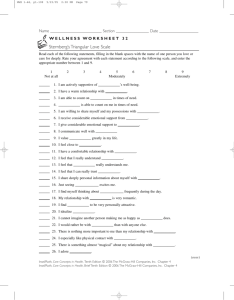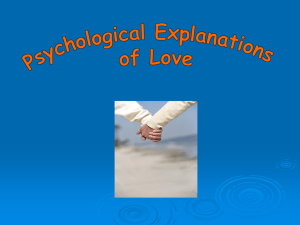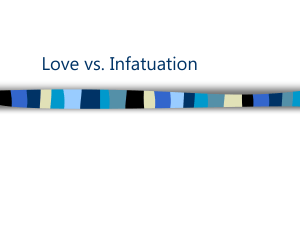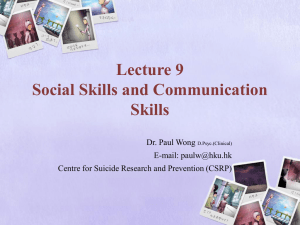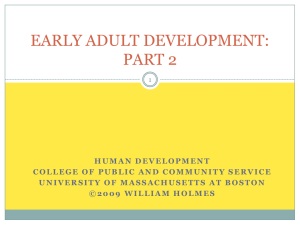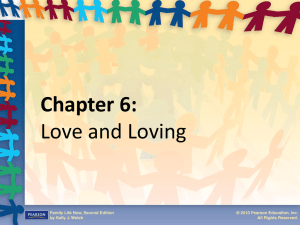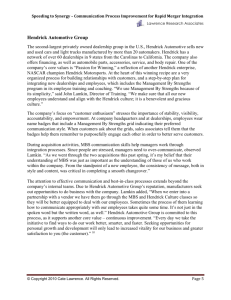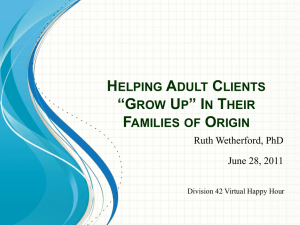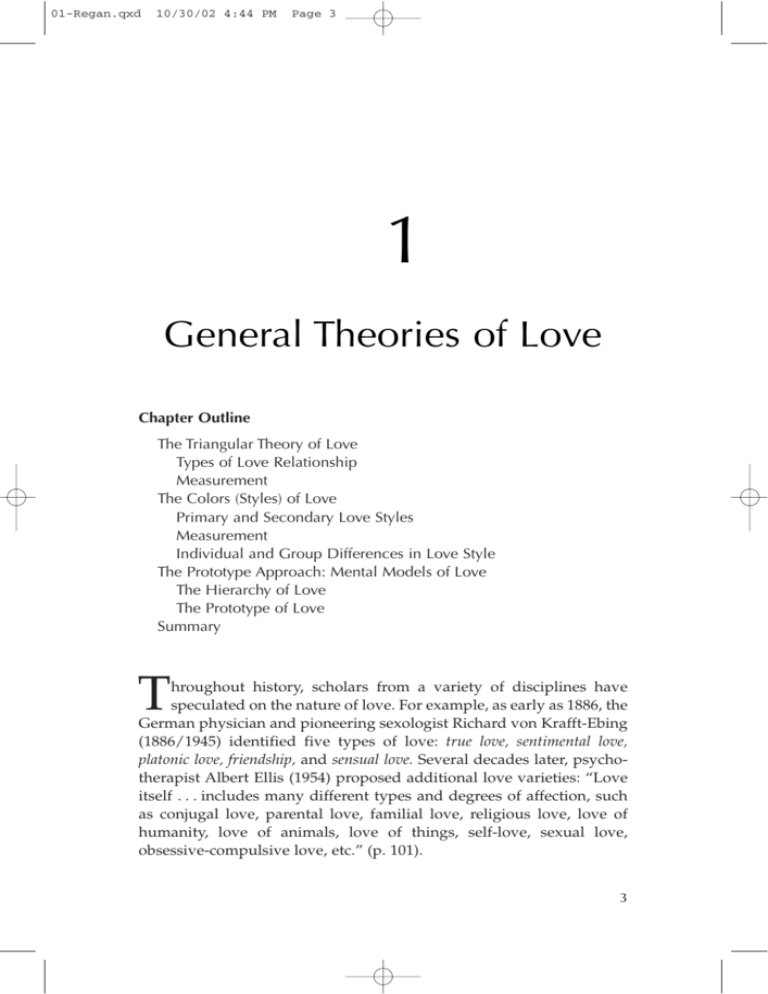
01-Regan.qxd
10/30/02 4:44 PM
Page 3
1
General Theories of Love
Chapter Outline
The Triangular Theory of Love
Types of Love Relationship
Measurement
The Colors (Styles) of Love
Primary and Secondary Love Styles
Measurement
Individual and Group Differences in Love Style
The Prototype Approach: Mental Models of Love
The Hierarchy of Love
The Prototype of Love
Summary
T
hroughout history, scholars from a variety of disciplines have
speculated on the nature of love. For example, as early as 1886, the
German physician and pioneering sexologist Richard von Krafft-Ebing
(1886/1945) identified five types of love: true love, sentimental love,
platonic love, friendship, and sensual love. Several decades later, psychotherapist Albert Ellis (1954) proposed additional love varieties: “Love
itself . . . includes many different types and degrees of affection, such
as conjugal love, parental love, familial love, religious love, love of
humanity, love of animals, love of things, self-love, sexual love,
obsessive-compulsive love, etc.” (p. 101).
3
01-Regan.qxd
4
10/30/02 4:44 PM
Page 4
LOVE
One of Ellis’s contemporaries, religious theoretician C. S. Lewis
(1960/1988), devoted an entire book to a discussion of types of love.
Drawing on earlier distinctions made by Greek philosophers, he proposed four main varieties. Affection (or Storge, pronounced “Stor-gay”)
is based on familiarity and repeated contact and resembles the strong
attachment seen between parents and children. This type of love is
experienced for and by a wide variety of objects, including family
members, pets, acquaintances, and lovers. Affectionate love has a
“comfortable, quiet nature” (p. 34) and consists of feelings of warmth,
interpersonal comfort, and satisfaction in being together. The second
variety of love depicted by Lewis is Friendship (or Philias). Common
interests, insights, or tastes, coupled with cooperation, mutual respect,
and understanding, form the core of this love type. Lewis argued that
Friendship, more than mere companionship, “must be about something, even if it were only an enthusiasm for dominoes or white mice”
(p. 66). Eros, or “that state which we call ‘being in love’” (p. 91), is the
third variety of love. Unlike the other love types, Eros contains a mixture of “sweetness” and “terror” as well as a sexual component that
Lewis referred to as Venus. Erotic love also is characterized by affection, idealization of and preoccupation with the beloved, and a short
life span. The final love type is Charity, a selfless and “Divine Gift-love”
that has no expectation of reward and desires only what is “simply best
for the beloved” (p. 128).
Contemporary social and behavioral scientists also have proposed
taxonomies that specify types or varieties of love (for reviews, see
Hendrick & Hendrick, 1992; Sternberg & Barnes, 1988). Two of the more
common classification schemes were developed by psychologist Robert
Sternberg (e.g., 1986, 1998) and sociologist John Lee (e.g., 1973, 1988).
THE TRIANGULAR THEORY OF LOVE
Sternberg (e.g., 1986, 1998) conceptualized love in terms of three basic
components that form the vertices of a triangle: intimacy, passion, and
decision/commitment (Figure 1.1). The intimacy component is primarily
emotional or affective in nature and involves feelings of warmth, closeness, connection, and bondedness in the love relationship. The passion
component is motivational and consists of the drives that are involved in
romantic and physical attraction, sexual consummation, and related
phenomena. The decision/commitment component is largely cognitive and
01-Regan.qxd
10/30/02 4:45 PM
Page 5
General Theories of Love
Figure 1.1
5
Sternberg’s Triangular Model of Love. The three components
of love are indicated at the vertices of the triangle. The various
types of love produced by different combinations of the
components are in brackets.
[Liking]
INTIMACY
[Nonlove]
[Romantic Love]
[Companionate Love]
[Consummate Love]
PASSION
[Infatuation]
[Fatuous Love]
DECISION/
COMMITMENT
[Empty Love]
SOURCE: From Sternberg, R. J. (1988). Triangulating love. In R. J. Sternberg &
M. L. Barnes (Eds.), The psychology of love (pp. 119-138). New Haven, CT: Yale
University Press. Copyright © 1988 by Yale University Press. Adapted with
permission.
represents both the short-term decision that one individual loves another
and the longer term commitment to maintain that love.
According to Sternberg, these three love components differ with
respect to a number of properties, including stability, conscious controllability, and experiential salience. For example, the elements of intimacy
and decision/commitment are usually quite stable in close relationships (once they occur and become characteristic of a relationship, they
01-Regan.qxd
6
10/30/02 4:45 PM
Page 6
LOVE
tend to endure), whereas passion tends to be less stable and predictable.
In addition, whereas people possess a great deal of conscious control
over the commitment that they make to relationships and possess at
least some degree of control over their feelings of intimacy, they actually have very little conscious control over the amount of passion that
they experience for their partners. The three components also differ in
terms of their experiential salience. Specifically, an individual is usually
quite aware of the passion component, but awareness of the intimacy
and decision/commitment components can be extremely variable.
That is, a person may experience feelings of intimacy (e.g., closeness,
connection, warmth) without explicitly being aware of those feelings or
even being able to identify what he or she is feeling. Similarly, a person
might not consciously realize the full extent of his or her commitment
to the relationship and the partner.
Types of Love Relationship
The three basic components of love combine to produce eight different love types, summarized in Table 1.1. Nonlove (no intimacy, passion, or decision/commitment) describes casual interactions that are
characterized by the absence of all three love components. Most of our
personal relationships (which are essentially casual associations) can
be defined as nonlove. Liking (intimacy alone) relationships are essentially friendship. They contain warmth, intimacy, closeness, and other
positive emotional experiences but lack both passion and decision/
commitment. Infatuation (passion alone) is an intense, “love at first
sight” experience that is characterized by extreme attraction and
arousal in the absence of any real emotional intimacy and decision/
commitment. In empty love (decision/commitment alone) relationships,
the partners are committed to each other and the relationship but lack
an intimate emotional connection and passionate attraction. This type
of love is often seen at the end of long-term relationships (or at the
beginning of arranged marriages). Romantic love (intimacy + passion)
consists of feelings of closeness and connection coupled with strong
physical attraction. Companionate love (intimacy + decision/commitment)
is essentially a long-term, stable, and committed friendship that is
characterized by high amounts of emotional intimacy, the decision to
love the partner, and the commitment to remain in the relationship.
This type of love is often seen in “best friendships” that are nonsexual
or in long-term marriages in which sexual attraction has faded.
01-Regan.qxd
10/30/02 4:45 PM
Page 7
General Theories of Love
Table 1.1
7
Sternberg’s Typology of Love Relationships
Love Component
Kind of Love Relationship
Nonlove
Liking
Infatuation
Empty love
Romantic love
Companionate love
Fatuous love
Consummate love
Intimacy
Passion
Decision/Commitment
Low
High
Low
Low
High
High
Low
High
Low
Low
High
Low
High
Low
High
High
Low
Low
Low
High
Low
High
High
High
NOTE: According to Sternberg (e.g., 1986), the three basic components of
love—intimacy, passion, and decision/commitment—combine to produce
eight different types of love relationship. For example, infatuation-based
relationships are characterized by relatively high levels of passion but
relatively low levels of intimacy and commitment.
Couples who experience fatuous love (passion + decision/commitment)
base their commitment to each other on passion rather than on deep
emotional intimacy. These “whirlwind” relationships are typically
unstable and at risk for termination. Finally, consummate love (intimacy +
passion + decision/commitment) results from the combination of all
three components. According to Sternberg, this is the type of “complete” love that many individuals strive to attain, particularly in their
romantic relationships.
Because the three basic components of love occur in varying degrees
within a relationship, most love relationships will not fit cleanly into one
particular category but will reflect some combination of categories.
Measurement
Sternberg (1998) developed a 45-item scale to assess the three basic
elements of love. The Intimacy subscale consists of 15 items designed
to reflect feelings of warmth, support, self-disclosure, trust, and other
aspects of intimate connection. Examples include “I receive considerable emotional support from _____,” “I feel close to _____,” “I feel that
I can really trust _____,” and “I share deeply personal information
about myself with _____.” The 15 items that make up the Passion
01-Regan.qxd
8
10/30/02 4:45 PM
Page 8
LOVE
subscale are designed to capture the more intense, physical, and exciting
elements of romantic relationships, including “Just seeing _____ excites
me,” “I especially like physical contact with _____,” “I adore _____,”
and “I fantasize about _____.” The Decision/Commitment subscale
contains 15 items that assess feelings of stability, commitment, and permanence. Examples include “I view my commitment to _____ as a solid
one,” “I have confidence in the stability of my relationship with _____,”
“I plan to continue in my relationship with _____,” and “I will always
feel a strong responsibility for _____.”
Interestingly, although this scale was designed to measure three distinct aspects of love—intimacy, passion, and decision/commitment—
empirical evidence suggests that it may actually measure one general
aspect of love. For example, psychologists Clyde and Susan Hendrick
(1989) administered the Triangular Love Scale to a large sample of men
and women. Their results indicated that the three subscales were highly
intercorrelated and also that the items formed a unifactorial scale. In
other words, the scale appeared to measure one global love dimension
rather than three distinct elements or components of love. Perhaps for
this reason, the scale has not received widespread use among social
scientists interested in examining people’s love experiences.
THE COLORS (STYLES) OF LOVE
Another contemporary theory of love, and one that has produced a
widely used measurement instrument, is the typology developed by
Lee (e.g., 1977, 1988). In this novel approach, each variety of love is
likened to a primary or secondary color (hence the title of Lee’s [1973]
book, Colours of Love).
Primary and Secondary Love Styles
According to Lee, there are three primary colors or styles of loving.
The first, eros, is an intensely emotional experience that is similar to
passionate love. In fact, the most typical symptom of eros is an immediate and powerful attraction to the beloved individual. The erotic lover
is “turned on” by a particular physical type, is prone to fall instantly
and completely in love with a stranger (i.e., to experience “love at first
sight”), rapidly becomes preoccupied with pleasant thoughts about that
individual, feels an intense need for daily contact with the beloved, and
01-Regan.qxd
10/30/02 4:45 PM
Page 9
General Theories of Love
9
wishes the relationship to remain exclusive. Erotic love also has a strong
sexual component. For example, the erotic lover desires the beloved
sexually, usually seeks some form of sexual involvement fairly early in
the relationship, and enjoys expressing his or her affection through
sexual contact. In sum, the erotic lover is “eager to get to know the
beloved quickly, intensely—and undressed” (Lee, 1988, p. 50).
The second primary color of love is ludus (or game-playing) love.
The ludic lover views love as a game to be played with skill and often
with several partners simultaneously. The ludic lover has no intention
of including the current partner (or partners) in any future life plans or
events and worries about any sign of growing involvement, need, or
intense attachment from the partner. As the quintessential commitmentphobe, the ludic lover avoids seeing the partner too often, believes that
lies and deception are justified, and expects the partner to remain in
control of his or her emotions. In addition, ludic lovers tend to prefer a
wide variety of physical types and view sexual activity as an opportunity
for pleasure rather than for intense emotional bonding.
Storge is the third primary love color. Described by Lee (1973) as
“love without fever or folly” (p. 77), storge resembles Lewis’s concept
of Affection in that it is stable and based on a solid foundation of trust,
respect, and friendship. Indeed, the typical storgic lover views and
treats the partner as an “old friend,” does not experience the intense
emotions or physical attraction to the partner associated with erotic
love, prefers to talk about and engage in shared interests with the
partner rather than to express direct feelings, is shy about sex, and
tends to demonstrate his or her affection in nonsexual ways. To the
storgic lover, love is an extension of friendship and an important part
of life but is not a valuable goal in and of itself.
Like the primary colors, these primary love styles can be combined
to form secondary colors or styles of love. The three secondary styles
identified by Lee contain features of the primary love styles but also
possess their own unique characteristics. Pragma, a combination of
storge and ludus, is “the love that goes shopping for a suitable mate”
(Lee, 1973, p. 124). The pragmatic lover has a practical outlook on love
and seeks a compatible lover. He or she creates a shopping list of
features or attributes desired in the partner and selects a mate based
on how well that individual fulfills the requirements (similarly, he or
she will drop a partner who fails to “measure up” to expectations).
Pragmatic love is essentially a faster-acting version of storge that has
been quickened by the addition of ludus.
01-Regan.qxd
10
10/30/02 4:45 PM
Page 10
LOVE
Mania, the combination of eros and ludus, is another secondary
love style. Manic lovers lack the self-confidence associated with eros
and the emotional self-control associated with ludus. This obsessive,
jealous love style is characterized by self-defeating emotions, desperate
attempts to force affection from the beloved, and the inability to believe
in or trust any affection the loved one actually does display. The manic
lover is desperate to fall in love and to be loved, begins immediately
to imagine a future with the partner, wants to see the partner daily,
tries to force the partner to show love and commitment, distrusts the
partner’s sincerity, and is extremely possessive. This love type is
“irrational, extremely jealous, obsessive, and often unhappy” (Lee,
1973, p. 15).
The last secondary color of love is agape, a combination of eros and
storge. Agape is similar to Lewis’s concept of Charity and represents an
all-giving, selfless love style that implies an obligation to love and care
for others without any expectation of reciprocity or reward. This love
style is universalistic in the sense that the typical agapic lover believes
that everyone is worthy of love and that loving others is a duty of the
mature person. With respect to personal love relationships, an agapic
lover will unselfishly devote himself or herself to the partner, even
stepping aside in favor of a rival who seems more likely to meet the
partner’s needs. Although Lee believed that many lovers respect and
strive to attain the agapic ideal, he also believed that the give-and-take
that characterizes most romantic relationships precludes the occurrence
of purely altruistic love.
Measurement
Lee’s classification scheme inspired the development of several
measurement instruments. The most well known and commonly used
is the 42-item Love Attitudes Scale (LAS) designed by the Hendricks
and their colleagues (Hendrick & Hendrick, 1986; Hendrick, Hendrick,
Foote, & Slapion-Foote, 1984). The LAS appears to reliably measure the
six love styles and has subsequently been redesigned so that each of the
items refers to a specific love relationship as opposed to more general
attitudes about love (Hendrick & Hendrick, 1990). A shorter, 28-item
version of the scale is also available (Hendrick, Hendrick, & Dicke,
1998). The complete scale, along with its shorter version, is reproduced
in Exhibit 1.1.
01-Regan.qxd
10/30/02 4:45 PM
Page 11
General Theories of Love
Exhibit 1.1
11
The Love Attitudes Scale
Instructions
Please answer the following items as honestly and accurately as possible.
Whenever possible, answer the questions with your current partner in mind.
If you are not currently dating anyone, answer the questions with your most
recent partner in mind. Otherwise, answer in terms of what you think your
responses would most likely be.
Response scale
1: strongly disagree
2: moderately disagree
3: neutral
4: moderately agree
5: strongly agree
Items
Eros
1. My partner and I were attracted to each other immediately after we
first met.
*2. My partner and I have the right physical “chemistry” between us.
3. Our lovemaking is very intense and satisfying.
*4. I feel that my partner and I were meant for each other.
5. My partner and I became emotionally involved rather quickly.
*6. My partner and I really understand each other.
*7. My partner fits my ideal standards of physical beauty/handsomeness.
Ludus
8. I try to keep my partner a little uncertain about my commitment to
him/her.
*9. I believe that what my partner doesn’t know about me won’t hurt
him/her.
*10. I have sometimes had to keep my partner from finding out about
other lovers.
11. I could get over my love affair with my partner pretty easily and
quickly.
*12. My partner would get upset if he/she knew of some of the things I’ve
done with other people.
13. When my partner gets too dependent on me, I want to back off a little.
*14. I enjoy playing the “game of love” with my partner and a number of
other partners.
Storge
15. It is hard for me to say exactly when our friendship turned into love.
16. To be genuine, our love first required caring for a while.
17. I expect to always be friends with my partner.
(Continued)
01-Regan.qxd
10/30/02 4:45 PM
12
Page 12
LOVE
Exhibit 1.1 Continued
*18.
*19.
*20.
*21.
Our love is the best kind because it grew out of a long friendship.
Our friendship merged gradually into love over time.
Our love is really a deep friendship, not a mysterious mystical emotion.
Our love relationship is the most satisfying because it developed
from a good friendship.
Pragma
22. I considered what my partner was going to become in life before I
committed myself to him/her.
23. I tried to plan my life carefully before choosing a partner.
24. In choosing my partner, I believed it was best to love someone with a
similar background.
*25. A main consideration in choosing my partner was how he/she would
reflect on my family.
*26. An important factor in choosing my partner was whether or not
he/she would be a good parent.
*27. One consideration in choosing my partner was how he/she would
reflect on my career.
*28. Before getting very involved with my partner, I tried to figure out
how compatible his/her hereditary background would be with mine
in case we ever had children.
Mania
29. When things aren’t right with my partner and me, my stomach gets
upset.
30. If my partner and I break up, I would get so depressed that I would
even think of suicide.
31. Sometimes I get so excited about being in love with my partner that I
can’t sleep.
*32. When my partner doesn’t pay attention to me, I feel sick all over.
*33. Since I’ve been in love with my partner, I’ve had trouble concentrating
on anything else.
*34. I cannot relax if I suspect that my partner is with someone else.
*35. If my partner ignores me for a while, I sometimes do stupid things to
try to get his/her attention back.
Agape
36. I try to always help my partner through difficult times.
*37. I would rather suffer myself than let my partner suffer.
*38. I cannot be happy unless I place my partner’s happiness before my
own.
*39. I am usually willing to sacrifice my own wishes to let my partner
achieve his/hers.
40. Whatever I own is my partner’s to use as he/she chooses.
41. When my partner gets angry with me, I still love him/her fully and
unconditionally.
*42. I would endure all things for the sake of my partner.
01-Regan.qxd
10/30/02 4:45 PM
Page 13
General Theories of Love
13
Scoring
Starred items are those included on the short form of the LAS. To find out
your love style, add up your ratings for the items in each subscale. Divide
this total by 7 (or by 4 if using the short form). You will have scores for the
three primary love styles and for the three secondary love styles. Is your
relationship characterized by one particular style of love? Or is it more
complex than that?
SOURCES: Adapted from Hendrick, C., & Hendrick, S. (1990). A relationshipspecific version of the Love Attitudes Scale. Journal of Social Behavior and
Personality, 5, 239-254. Copyright © 1990 by Select Press, Inc. Items reprinted
with permission. Starred items are included in the short form of the scale
from Hendrick, C., Hendrick, S. S., & Dicke, A. (1998). The Love Attitudes
Scale: Short Form. Journal of Social and Personal Relationships,
15, 147-159.
NOTE: Response options have been reversed from original source.
Individual and Group Differences in Love Style
Unlike the Triangular Love Scale, the LAS has been used in numerous empirical investigations. In general, the results of these studies
reveal that love experiences vary as a function of individual difference
and group variables. For example, many researchers find that women
score higher on the love styles of storge and pragma than do men,
whereas men tend to score higher on ludus (e.g., Dion & Dion, 1993;
Hendrick & Hendrick, 1987, 1988, 1995; Hendrick et al., 1984, 1998;
Rotenberg & Korol, 1995).
There also are multicultural and cross-cultural differences in love
style. Within the United States, Asian American adults often score lower
on eros and higher on pragma and storge than do Caucasian, Latino,
and African American adults (e.g., Dion & Dion, 1993; Hendrick &
Hendrick, 1986). Latino groups, on the other hand, often score higher
on ludus than do Caucasian groups (e.g., Contreras, Hendrick, &
Hendrick, 1996). And cross-cultural comparisons reveal that
Americans tend to be endorse a more storgic and manic approach to
love than do the French, who in turn tend to demonstrate higher levels
of agape (e.g., Murstein, Merighi, & Vyse, 1991).
These differences notwithstanding, it is important to keep in mind
that not all individuals possess one approach or style of loving. A man or
woman may adopt numerous love styles, and a person’s love style may
change over his or her lifetime or during the course of a given relationship. For example, the preoccupation and intense need associated with a
01-Regan.qxd
14
10/30/02 4:45 PM
Page 14
LOVE
manic love style may occur more often during the beginning stages of a
romantic relationship, when the partners are uncertain as to their feelings
and the future of their association. Over time, however, these feelings
may be replaced by more erotic, storgic, or agapic feelings.
THE PROTOTYPE APPROACH:
MENTAL MODELS OF LOVE
Some researchers, rather than following the theoretical “top-down”
approach adopted by Sternberg and Lee (and others), have taken an
empirically driven “bottom-up” approach to delineate the nature of
love. One such technique, the prototype approach, involves collecting
data directly from men and women about their knowledge, beliefs,
and attitudes—their mental representations—of the concept of love.
Researchers who use the prototype approach are interested in exploring what people think of when they are asked about love, how they differentiate love from related concepts (e.g., liking), how they form their
conceptualizations of love, and how these conceptualizations or mental representations influence their behavior with relational partners.
The Hierarchy of Love
According to Eleanor Rosch (e.g., 1973, 1975, 1978), an early pioneer
in the use of prototype analysis, natural language concepts (e.g., love, dog,
apple) can be viewed as having both a vertical and a horizontal dimension. The former concerns the hierarchical organization of concepts or
relations among different levels of concepts. Concepts at one level may
be included within or subsumed by those at a higher level. For example,
the set of concepts fruit, apple, and Red Delicious illustrate an abstract-toconcrete hierarchy with superordinate, basic, and subordinate levels.
Using the methods originally developed by Rosch, some
researchers have investigated the hierarchical structure of the concept
of love. Psychologist Phillip Shaver and colleagues (Shaver, Schwartz,
Kirson, & O’Connor, 1987), for instance, found evidence that love is a
basic-level concept contained within the superordinate category of
emotion and subsuming a variety of subordinate concepts that reflect
types or varieties of love (e.g., passion, infatuation, liking) (see Figure 1.2).
That is, most people consider passion, infatuation, and liking to be
types of love, which in turn is viewed as a type of positive emotion.
01-Regan.qxd
10/30/02 4:45 PM
Page 15
General Theories of Love
Figure 1.2
15
The Hierarchy of Love and Other Emotions. Research
conducted by Phillip Shaver, Beverley Fehr, and their
colleagues (Fehr & Russell, 1991; Fischer, Shaver, &
Carnochan, 1990; Shaver, Schwartz, Kirson, & O’Connor, 1987)
suggests that love is a basic level concept contained within the
superordinate category of emotion. In addition, love appears to
contain a variety of subordinate concepts that reflect types or
varieties of love; of these, maternal love is viewed as the most
prototypical variety.
superordinate
EMOTION
ANGER
JOY
LOVE
basic
Infatuation
Maternal love
Romantic love
Friendship
subordinate
The Prototype of Love
Concepts also may be examined along a horizontal dimension.
This dimension concerns the differentiation of concepts at the same
level of inclusiveness (e.g., the dimension on which subordinate-level
01-Regan.qxd
16
10/30/02 4:45 PM
Page 16
LOVE
concepts such as Red Delicious, Fuji, and Granny Smith apples vary).
According to Rosch, many natural language concepts or categories
have an internal structure whereby individual members of that category are ordered in terms of the degree to which they resemble the prototypic member of the category. A prototype is the best and clearest
example of the concept (the “appliest” or the most apple-like apple
[e.g., Red Delicious]). Individuals use prototypes to help them decide
whether a new item or experience belongs or “fits” within a particular
concept. For example, in trying to decide whether or not he is in love
with his partner, a man might compare the feelings (“I’m happy when
she’s here and I’m sad when she’s not”), thoughts (“I think about her all
of the time,” “I wonder what our children would look like”), and behaviors (“I rearrange my schedule to spend time with her, and we go everywhere together”) he has experienced during their relationship with his
prototype—his mental model—of “being in love” (“People who are in
love miss each other when they’re apart, think about each other a lot,
imagine a future life together, and spend a lot of time with each other”).
If what the man is experiencing “matches” his prototype, he is likely to
conclude that he is, in fact, in love with his partner.
The prototype approach has been used to explore the horizontal
structure of a variety of relational concepts, including love. Beverley
Fehr and James Russell (1991), for example, asked men and women to
generate as many types of love as they could in a specified time and
then asked another sample of individuals to rate these love varieties in
terms of prototypicality or “goodness-of-example.” Of the 93 subtypes
generated, maternal love was rated as the best or most prototypical
example of love, followed by parental love, friendship, sisterly love, romantic love, brotherly love, and familial love. Infatuation, along with sexual love
and puppy love, was considered one of the least prototypical examples
of love.
Researchers also have identified the prototypic features (as
opposed to types) of love. For example, in an earlier demonstration,
Fehr (1988) asked one group of participants to list the characteristics of
the concept of love and a second group to rate how central each feature
was to the concept of love. Features that her participants believed were
central or prototypical to love included trust, caring, honesty, friendship,
respect, concern for the other’s well-being, loyalty, and commitment.
Features that were considered peripheral or unimportant to the concept of love included see only the other’s good qualities, butterflies in stomach, uncertainty, dependency, and scary.
01-Regan.qxd
10/30/02 4:45 PM
Page 17
General Theories of Love
17
More recently, psychologists Arthur Aron and Lori Westbay (1996)
extended Fehr’s work by exploring the underlying structure of the prototype of love. These researchers found evidence that the 68 prototypic
love features identified by participants in Fehr’s (1988) study could
be reduced reliably to three latent dimensions that resembled those
included in Sternberg’s triangular theory of love typology: passion,
intimacy, and commitment. Thus, Sternberg’s theory appears sound;
that is, the love experiences of many men and women do indeed reflect
the three basic dimensions he proposed.
SUMMARY
Social and behavioral scientists, recognizing the important role that
love plays in human life, have theorized about its nature. In the
process, they have proposed a number of typologies or classification
schemes that specify types or varieties of love. Other researchers, following a prototype approach, have attempted to delineate the nature of
love by examining people’s common understandings of love and their
love experiences. This body of theoretical and empirical work reveals
that there exist a multitude of ways of loving. Love truly is a many
splendored—and multifaceted—experience.
KEY CONCEPTS
Storge (p. 4)
Philias (p. 4)
Eros (p. 4)
Charity (p. 4 )
Triangular theory of love (pp. 4-5 )
Intimacy component (p. 4)
Passion component (p. 4)
Decision/commitment component (pp. 4-5 )
Stability property (pp. 5-6)
Conscious controllability property (pp. 5-6)
Experiential salience property (pp. 5-6)
Nonlove (p. 6)
Liking (p. 6)
Infatuation (p. 6)
01-Regan.qxd
18
10/30/02 4:45 PM
Page 18
LOVE
Empty love (p. 6)
Romantic love (p. 6)
Companionate love (p. 6)
Fatuous love (p. 7)
Consummate love (p. 7)
Erotic love style (p. 8)
Ludic love style (p. 9)
Storgic love style (p. 9)
Pragmatic love style (p. 9)
Manic love style (p. 10)
Agapic love style (p. 10)
Concepts (p. 14)
Vertical dimension of the concept of love (p. 14)
Horizontal dimension of the concept of love (p. 15)
Prototype (p. 16)
DISCUSSION QUESTIONS
1. Why have scientists tended to devote so much attention to
romantic or passionate love? Do you think that this focus has
helped or hindered our understanding of love in general?
2. Although philosophers, poets, and writers have speculated on
the nature of love for many hundreds of years, the topic of love
has only recently begun to receive scientific attention. What do
you think might account for this state of affairs?
3. Describe Sternberg’s (1988) triangular theory of love. Select two
relationships you have seen portrayed in the media (e.g., books,
plays, movies, television). Which type of love does each relationship illustrate? Describe each in terms of the three components of
love.
4. Define the three primary and three secondary colors of love.
What would be the best pairing of love styles? The worst? Why?
5. Scientists interested in the nature of love have tended to adopt
a theory-driven “top-down” approach (e.g., Sternberg, Lee) or a
data-driven “bottom-up” approach (e.g., Fehr, the prototype
researchers). What does each approach contribute to our understanding of love? Is one better than the other? Why or why not?
01-Regan.qxd
10/30/02 4:45 PM
Page 19
General Theories of Love
19
RECOMMENDED READINGS
Hendrick, C., & Hendrick, S. S. (1989). Research on love: Does it measure up?
Journal of Personality and Social Psychology, 56, 784-794.
In this classic article, the authors examine whether the available love instruments
actually measure what they purport to measure.
Lee, J. A. (1973). Colours of love: An exploration of the ways of loving. Toronto: New
Press.
This book serves as a wonderful introduction to the author’s theory. Although
out of print (check the library or a used book store), it is well worth the effort to
locate it.
Kephart, W. M. (1967). Some correlates of romantic love. Journal of Marriage and
the Family, 29, 470-474.
Simpson, J. A., Campbell, B., & Berscheid, E. (1986). The association between
romantic love and marriage: Kephart (1967) twice revisited. Personality and
Social Psychology Bulletin, 12, 363-372.
In 1967, Kephart asked a group of men and women whether love was essential for
marriage. Twenty years later, Simpson and his colleagues did the same. The
results revealed that attitudes about the association between love and marriage
had changed dramatically over time, particularly among women.
Sternberg, R. J., & Barnes, M. L. (Eds.). (1988). The psychology of love. New
Haven, CT: Yale University Press.
Although dated, this book remains a valuable reference tool for people interested
in understanding social scientific views of love.

